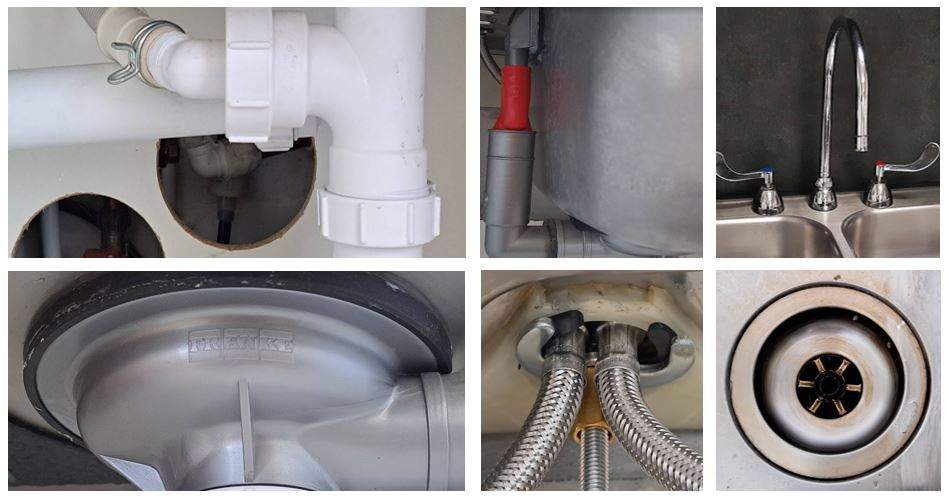A leaking kitchen sink can be frustrating. It disrupts daily routines.
So, why is your kitchen sink leaking underneath? A leak under the kitchen sink often indicates a problem that needs fixing. It could be worn-out seals, loose connections, or clogged drains. Water damage from leaks can lead to mold growth and other issues.
Addressing the problem quickly helps prevent costly repairs. This post will explore common reasons for kitchen sink leaks and provide tips on identifying and fixing these issues. This will keep your kitchen dry and functional. Stay with us to learn how to tackle this common household problem.

Common Causes
Is your kitchen sink leaking underneath? There are several possible causes. Understanding the common causes can help you fix the problem quickly. Let’s explore some of the most typical reasons.
Loose Connections
One of the most common causes of leaks under the kitchen sink is loose connections. Over time, the connections between pipes and fittings can become loose, allowing water to seep out.
- Check the connections between the sink and the plumbing pipes.
- Ensure that all nuts and bolts are tight.
- Look for any signs of rust or damage.
Regularly inspecting these connections can prevent leaks. Tightening them with a wrench can often fix the issue.
Worn Out Seals
Another frequent cause is worn-out seals. Seals around the sink drain can wear out or crack. This allows water to escape.
- Inspect the seal around the sink drain.
- Look for any cracks or signs of wear.
- Replace the seal if it looks damaged.
Replacing old seals can stop leaks and save water. It’s a simple fix that can make a big difference.
| Cause | Solution |
|---|---|
| Loose Connections | Tighten with a wrench |
| Worn Out Seals | Replace the seal |
Understanding these common causes can help you fix your leaking kitchen sink. Regular checks and maintenance can also keep your sink in good working order.

Credit: m.youtube.com
Identifying The Leak Source
Discovering a leak under your kitchen sink can be stressful. To fix it, you must first identify the source. This step is crucial, as it ensures you tackle the real problem.
Visual Inspection
Start by doing a visual inspection. Open the cabinet doors under the sink. Look for obvious signs of leaking. Check the pipes and connections. Do you see any drips? Examine the area around the sink drain. Is there moisture or water pooling?
Next, use a flashlight. It helps you see in dark areas. Inspect the faucet connections. Are they loose or corroded? If you have a garbage disposal, check it. Look for leaks or water stains. A thorough inspection can often reveal the source.
Water Stains And Damage
Look for water stains and damage. These are clear indicators of leaks. Water stains usually appear as dark or discolored patches. They can be on the cabinet floor or walls.
Feel the area around the sink. Is the wood swollen or soft? This could mean water damage. Check for mold or mildew. These thrive in moist environments. They are often found in hidden places.
Use a dry cloth to wipe the pipes and connections. Observe if any moisture appears. This can help pinpoint slow leaks. Remember, even small leaks can cause significant damage over time.
Identifying the leak source allows you to take the following steps to fix it. Thorough inspection and attention to detail are key. This helps ensure your kitchen sink remains leak-free.
Faulty Pipe Joints
Faulty pipe joints are one of the common causes of kitchen sink leaks. These joints connect the various pipes under your sink. Over time, they can become loose or damaged, leading to leaks. Identifying and fixing these issues promptly can prevent bigger problems.
Signs Of Damage
Look for water puddles under the sink. This is a clear sign of damage. You might also notice water stains or moisture on the cabinet floor. Another sign is a musty smell. This indicates water leakage and possible mold growth. Checking these signs regularly can help you catch issues early.
How To Fix
First, turn off the water supply to your sink to prevent further leakage while you work. Next, inspect the pipe joints for any visible damage. Tighten loose joints with a wrench. If the joints are cracked or broken, replace them. Use the plumber’s tape on the threads to ensure a tight seal. Once done, turn the water back on and check for leaks. If the problem persists, consider calling a professional plumber.

Credit: www.reddit.com
Leaky Sink Strainer
A leaky sink strainer can cause a lot of trouble in your kitchen. A common issue can lead to water damage if not fixed. The sink strainer helps drain water while catching food particles. Over time, it can wear out or get damaged, leading to leaks underneath the sink.
Symptoms
There are a few signs that your sink strainer might be leaking. You may notice water pooling under the sink. This water can cause damage to the cabinet or floor. Another symptom is a musty smell coming from the sink area. This smell is due to moisture collecting in hidden places. Sometimes, you might see water stains on the bottom of the sink cabinet. These stains are a clear sign of a leak.
Replacement Steps
To replace a leaky sink strainer, follow these steps:
- First, turn off the water supply to the sink.
- Next, place a bucket under the sink to catch any water.
- Loosen the nuts holding the strainer in place using pliers.
- Remove the old strainer and clean the sink opening.
- Apply the plumber’s putty around the new strainer’s edge.
- Press the new strainer into the sinkhole.
- From under the sink, tighten the nuts to secure the new strainer.
- Check for leaks by running water and inspecting the area.
Replacing the strainer is not too difficult. It can prevent bigger problems later. After fixing it, always check for leaks.
Damaged Faucet
One common cause of a leaking kitchen sink is a damaged faucet. Over time, faucets can develop different types of leaks. Understanding these leaks and how to repair them can prevent a big mess.
Types Of Faucet Leaks
There are several types of faucet leaks. The most common is a dripping faucet, which happens when the washer or O-ring inside the faucet wears out. Another common type is a leak around the base, which usually means the seal or gasket is damaged.
A less common type is a spout leak. This occurs when the spout itself is cracked. Each of these leaks requires a different approach to repair.
Repair Tips
Fixing a dripping faucet often involves replacing the washer or O-ring. First, turn off the faucet’s water supply. Then, disassemble the faucet and remove the old washer. Replace it with a new one and reassemble the faucet.
Check the seal or gasket for leaks around the base. Tighten any loose parts. If the gasket is damaged, replace it. Ensure the new gasket fits snugly.
A spout leak repair might require a new spout. Remove the old spout and inspect it for cracks. If it is cracked, replace it with a new one. Reassemble the faucet and test for leaks.
Clogged P-trap
A leaking kitchen sink can be very frustrating. One common cause is a clogged P-trap, the curved pipe under your sink. The P-trap traps debris and keeps sewer gases from coming up. When it gets clogged, water backs up and leaks.
Signs Of Clogs
Do you notice slow-draining water in your sink? This is often the first sign of a clogged P-trap. You may also hear gurgling sounds as water drains. Another sign is a foul smell coming from the sink. This happens when trapped debris starts to rot.
Clearing The P-trap
First, place a bucket under the P-trap to catch water. Next, use a wrench to loosen the slip nuts on both sides. Carefully remove the P-trap and inspect it for debris. Use a brush to clean out any clogs. Once clean, reattach the P-trap and tighten the slip nuts. Run water to check for leaks.
Preventive Measures
Preventing leaks under your kitchen sink can save you time, money, and stress. A few simple steps can help you avoid potential problems. Here are some key preventive measures to consider.
Regular Maintenance
Regular maintenance is essential to keeping your sink in good condition. Check for signs of wear and tear, tighten loose connections with a wrench, and clean the sink and pipes regularly. This helps prevent clogs and buildup. Inspect the faucet and seals for leaks, and replace worn-out parts before they cause more significant issues.
Proper Installation
Proper installation is crucial to avoid future leaks. Make sure all parts are fitted correctly. Follow the manufacturer’s instructions closely. Use the right tools and materials for the job. Ensure that the pipes are aligned and secure. Check for any gaps or misalignments. A well-installed sink is less likely to develop leaks over time.

Credit: leakdetection.co.uk
When To Call A Professional
Sometimes, a leaking kitchen sink requires a professional touch. Not every problem is easy to fix. Some may require tools you don’t have, and other times, the problem might be hard to find. In these cases, calling a plumber is the best choice.
Assessing The Situation
First, examine the leak closely and determine whether it is small or large. A small drip might be easy to fix, but a large leak can damage your home and require quick professional help.
Next, check where the water comes from. Is it from the pipes, drain, or faucet? If you can’t find the source, call a plumber. They have the skills to find hidden issues.
Finding A Plumber
Finding a good plumber is essential. Start by asking friends or family for recommendations. They may know a reliable plumber. You can also read reviews online. Look for plumbers with good ratings and positive feedback.
Check if the plumber is licensed and insured. This ensures that they are qualified to do the job. A licensed plumber has the training to handle various issues, and insurance protects you in case something goes wrong.
Once you find a plumber, ask for a quote. This helps you know the cost before they start the work. Good plumbers will give you a precise estimate.
Frequently Asked Questions
Why Is My Kitchen Sink Leaking Underneath?
A loose connection is a common cause of kitchen sink leaks. Check for worn-out seals or gaskets and tighten any loose fittings.
How Do I Fix A Leaking Kitchen Sink?
First, identify the leak source. Tighten connections and replace worn-out seals or gaskets. If the issue persists, consult a plumber.
What Causes A Kitchen Sink To Leak From The Bottom?
A leaking sink can result from a faulty drain assembly. Check for cracks or worn-out seals. Tighten all connections.
Can A Clogged Drain Cause A Sink To Leak?
Yes, a clogged drain can cause water backup, creating pressure and leading to leaks. To fix it, clear the blockage.
Maintenance Tips
A leaking kitchen sink can cause stress and damage. It is crucial to identify the problem.
- Check pipes and seals for wear.
- Tighten connections to prevent future leaks.
- Regular maintenance helps avoid issues.
- Don’t ignore small drips; they often lead to more significant problems.
Fix leaks promptly to save time and money. Keep your kitchen sink in top shape to ensure a clean and functional kitchen. Simple steps can make a big difference. Protect your home by staying proactive.


